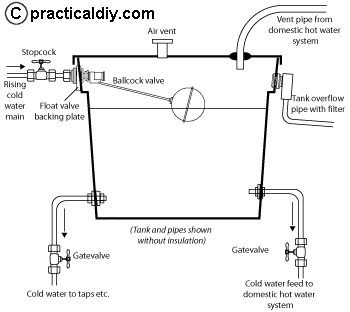Cold Water Tank
The cold water tank in a vented cold water system stores the large volume of water to supply the hot and cold water systems that are not directly fed by the rising main.

The water level within the tank is controlled by a float operated valve which is set to allow water to enter when the water level drops below the required level.
If the float operated valve should fail, water will continue to enter the tank, raising the water level until it reached the overflow pipe, at which point the water will be discharged though the overflow pipe and, hopefully,give a warning of the problem.
On plastic water tanks, the float valve needs to be fitted with a backing plate to stiffen the side of the tank and prevent it flexing when the valve is operated.
Since the 1970’s, plastic cold water tanks have been used; in older properties galvanized or even asbestos tanks may still be found.
The old galvanized tanks do suffer from corrosion and after a period do need replacement.
The asbestos tanks are safe while in use but when they are replaced, they need to be dealt with appropriately - never cut or break an asbestos tank as the dust created will be extremely dangerous if inhale; even a minute particle can be hazardous to your health.
Cold water tanks fitted since the early 1990's should meet Byelaw 30 which is designed to prevent contamination of the stored water; this involves having a tight fitting lid and the overflow incorporating a screen to prevent small insects from traveling along the overflow and contaminating the water in the tank.
The hole where any pipe passes through the lid of the tank (such as the vent pipe from a domestic hot water system) also needs to be sealed, usually a rubber grommet is fitted over the pipe and located in the lid.
The illustration above shows a typical modern arrangement of a stopcock in the feed to the tank and gatevalves on the outlets; in older installations these may not be fitted.
The purpose of the gatevalves is to be able to isolate the tank from the pipework it feeds, this means that when work is required along the pipework (such as changing a tap washer), there is no need to drain down and waste the tank full of stored water.
